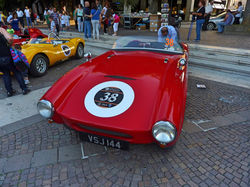
1960 Watford Cheetah Sport
.jpg)
All photography work is copyrighted by the author, please don't download and publish these pictures in the internet without my permission!
Larger high quality pictures is available only for donators up on request! Vasileios Papaidis 2018 © All Rights Reserved
This 1960 Watford Cheetah is said to be one of 25 kits ever made, and sale includes a removable, wraparound windshield and matching hardtop as well–both were optional. One of the prettier fiberglass sidevalve Ford specials that popped up during the late 50’s and 60’s.
The Watford Cheetah was designed and built by former employees of Tornado Cars LTD, B.J. Millar, K.J. Hynder and J.G. Bound. Launched in 1959 the Cheetah chassis and body units could be bought separately for the price of £70 and £130 respectively. But as they were made to go together there seemed little point and all Cheetahs known to survive have both the Watford chassis and body.
The chassis is very similar to the Tornado chassis and with claims in their sales booklet of "a frame of great rigidity and strength with the minimum of weight at low cost" you would expect that it was of the highest quality. But these guys had obviously learnt very little from Bill Woodhouse and Co and subsequent owners have found stress cracks in the main rails adjacent to the drivers feet and also in the out rigger at the rear to which the petrol tank is mounted. This area has no triangulation and so a butt welded ladder frame is expected to take all the stress.
The 1954 Tornado Typhoon frame was a patented front axle of the Watford, rear-mounted axle from the Ford 93 A. The engine selection conventionally fell on the then-popular Ford four-cylinder a 1172 cc SV (drilling x 63.5 x 92.5 mm stroke) that was used at the time, for example, by Colin Chapman in Lotus Six and Seven and Tornado. When fitted with two SU carburettors, it gave 40 hp at compression level 7. By default, the corresponding three-speed Ford transmission was also fitted.
The frame was screwed with a very nice stylish laminate body, which formed one whole including the partitions.She set up two seats, hoods and doors. Roadster could be fitted with a top hat roof with a large arched plexiglass rear window; in this case, the windshield was placed in the frame that served to anchor the roof. Brakes on all wheels were drum. Tires were 17 "in size, steel discs.
The car's wheelbase is 2438 mm and the other dimensions have not yet been traced. The weight can be estimated at around 500kg, so even the low-performance engine gave the car an acceptable dynamics, a speed of about 120 km / h and an acceleration to 100 km / h in about 18 seconds.
After all that they did make a very pretty and very well made and designed body shell. This, like the chassis was of 8` wheelbase and came complete with floor, bulkhead, two occasional rear seats, bootbase and was completely waterproof.
Extras included a wrap round windscreen, hard top and fibreglass hub caps for Ford 17" wheels.
Prices and specification never changed throughout its production which seemed to cease in late 1961.
The car photographed by me at Circuito di Avezzano 2015 & 2017.


Rare characteristic advertisements of that time for that particular type of cars made in G.B.
Photo Gallery



























